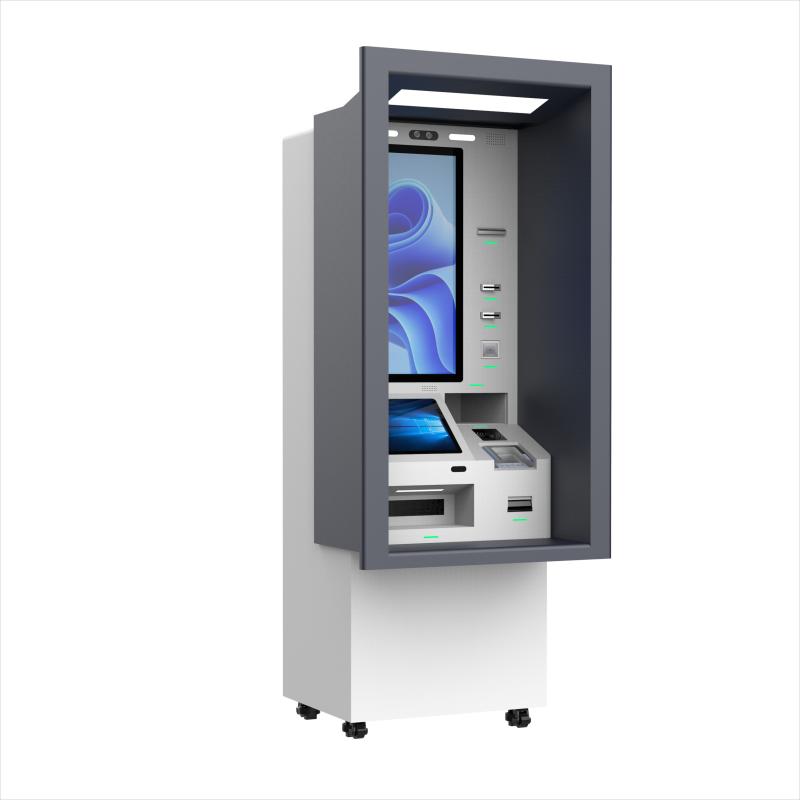A customized touch screen kiosk monitor refers to a specialized self-service terminal with a touch-sensitive display that has been tailored to meet specific functional, branding, and user experience requirements.
1. Touch-Sensitive Display: Utilizes a touch-sensitive screen that allows users to interact directly with the interface through touch gestures like tapping, swiping, and pinching.
2. Integrated Computing Capability: Contains a built-in computer or computing device capable of running software applications, processing data, and connecting to networks for various functionalities.
3. High-Quality Display: Features a high-resolution LCD or LED display that provides clear and vibrant visuals for displaying information, graphics, and multimedia content.
4. User-Friendly Interface: Designed with an intuitive user interface (UI) that enables easy navigation and interaction, ensuring a seamless user experience.
5. Versatile Applications: Supports a wide range of applications and services, including:
- Information dissemination (e.g., directories, maps, product catalogs).
- Transactional services (e.g., ticketing, payments, reservations).
- Interactive experiences (e.g., surveys, virtual tours).
6. Peripheral Integration: Includes interfaces or ports for integrating peripheral devices such as printers, bar-code scanners, card readers, and cameras to extend functionality and support specific tasks.
7. Connectivity Options: Provides connectivity through Ethernet, Wi-Fi, and sometimes cellular networks, enabling access to online services, real-time data updates, and remote management capabilities.
8. Security Features: Incorporates security measures to protect user data and ensure secure transactions, including encryption protocols, secure login procedures, and physical security enhancements.
9. Customization Capabilities: Allows customization in terms of:
- Branding and visual design to reflect corporate identity.
- Content management to display tailored information or promotional content.
- Hardware configuration to meet specific functional requirements and environmental conditions.
10. Durability and Reliability: Built with durable materials and components to withstand frequent use in public environments, ensuring reliability and longevity of the kiosk system.

- Improved Customer Experience : Provides an engaging and efficient way for users to access information or complete transactions.
- Cost Savings : Reduces labor costs and can lead to increased sales through targeted promotions and easy access to product information.
1. Design and Enclosure Customization:
- Material Selection: Choose materials for the kiosk enclosure that suit the deployment environment (e.g., stainless steel for durability, weather-resistant plastics for outdoor use).
- Enclosure Size and Shape: Design the kiosk in sizes and shapes that optimize usability and fit within the intended space, considering accessibility and user comfort.
- Custom Finishes: Apply custom finishes such as powder coating or specialized paints to match corporate branding or blend with the environment.
2. Touch Screen Interface:
- Touch Technology: Select the appropriate touch technology (e.g., capacitive, resistive) based on user requirements, environmental conditions, and expected usage patterns.
- Multi-Touch Support: Implement multi-touch capabilities to support gestures like pinch-to-zoom and swiping, enhancing user interaction and usability.
3. Display Configuration:
- Screen Size and Resolution: Determine the optimal screen size and resolution based on visibility requirements and viewing distances in the deployment environment.
- High-Brightness Option: Choose displays with high brightness levels and anti-glare coatings for visibility in outdoor or brightly lit indoor environments.
4. Branding and Visual Identity:
- Logo and Graphics Integration: Incorporate company logos, branding elements, and promotional graphics into the kiosk interface and enclosure design.
- Customizable Themes: Implement customizable themes or templates for seasonal promotions, events, or specific marketing campaigns.
5. User Interface (UI) and User Experience (UX):
- Customizable UI Layout: Design intuitive and user-friendly UI layouts with customizable menus, buttons, and navigation paths to streamline user interactions.
- Personalization Options: Provide options for users to personalize settings such as language preferences, accessibility features, and font sizes.
6. Functional Customization:
- Application Integration: Integrate specific applications or software modules tailored to the kiosk's purpose, such as information kiosks, ticketing systems, or interactive directories.
- Peripheral Integration: Include ports or interfaces for peripherals such as barcode scanners, receipt printers, card readers, cameras, and sensors to extend functionality.
7. Security Features:
- Data Security Measures: Implement encryption protocols, secure authentication methods, and physical security features (e.g., locks, tamper-resistant enclosures) to protect user data and transactions.
- Privacy Enhancements: Integrate privacy screens, secure PIN entry pads, and data wiping capabilities to ensure user privacy and compliance with privacy regulations.
8. Accessibility Considerations:
- ADA Compliance: Design kiosks with features that comply with accessibility standards, such as tactile buttons, audio outputs, and adjustable height options for users with disabilities.
- Multilingual Support: Include language options and accessibility settings to cater to diverse user demographics and enhance usability for non-native speakers.
9. Compliance and Regulatory Requirements:
- Regulatory Compliance: Ensure compliance with industry regulations and standards related to data security, privacy, accessibility, and environmental safety relevant to the kiosk's deployment location.
By customizing a touch screen kiosk monitor with these considerations in mind, businesses can create a tailored solution that enhances user engagement, supports operational goals, and reinforces brand identity effectively across various deployment environments and use cases.